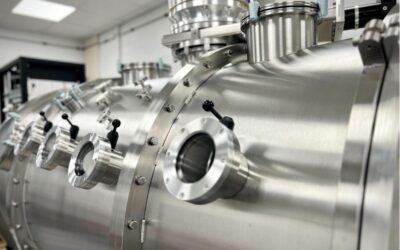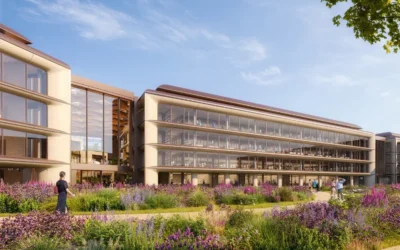Milton Park welcomed Professor Paul Monks CB, the government’s Chief Scientific Adviser at the Department for Energy Security and Net Zero (DESNZ) and members of the DESNZ team for a tour and roundtable discussion.
Tour attendees had an opportunity to see first-hand some of the boundaries being pushed at Milton Park, which is home to, quite literally, some of the universe’s coolest and hottest innovations.
Tokamak Energy’s Co-Founder Dr David Kingham introduced the team’s work in fusion energy, which sees their pioneering ST40 tokamak reach plasma temperatures six times hotter than the sun (100 million°C). The team then gave an overview of the breadth of applications on offer through TE Magnetics, the company’s high-temperature superconducting (HTS) magnets spinout.
At the other end of the thermometer, TreQ, a venture-backed quantum computing startup, demonstrated its open-architecture system, which operates just above absolute zero. The team explained how quantum systems like theirs could one day solve currently intractable simulation and optimisation problems across various sectors, including the energy sector, and reduce data centre energy consumption.
Earthshot-Prize nominees Nium showcased its nanotechnology-enabled, decentralised ammonia production system, giving a preview of their brand-new catalyser, which is the largest of its kind in the world. Designed to reduce energy intensity in hydrogen and fertiliser supply chains, the company has positioned its technology as a viable alternative to the traditional, carbon-intensive Haber-Bosch process of ammonia production.
Closing the tour, Nexeon demonstrated its pioneering Li-ion battery anode technology, which uses silicon instead of graphite and is cheaper and more efficient than counterparts. With a production facility in South Korea and headquarters in Oxfordshire, Nexeon’s battery technology is being scaled to support demand from global EV manufacturers and energy storage developers.
A roundtable discussion was then held at Bee House, with representatives from DESNZ, Advanced Oxford and the Oxford Growth Commission, alongside other Milton Park occupiers Electrogenos and Nuvia. The session focused on how the UK can scale innovation while aligning with its net zero targets, covering topics including infrastructure, investment, workforce skills and supply chain resilience.
The DESNZ visit follows the publication of the government’s Modern Industrial Strategy, which positioned clean energy industries and digital technologies as key growth-driving sectors for the UK economy over the coming decade.
“It was fascinating to see innovation happening at scale at Milton Park. This is clearly one of the places to be in the UK if you want to contribute to clean growth. Meeting the breadth of innovators on the visit made me feel very positive about the future of UK science and innovation. It was a fitting reminder that, as a country, we shouldn’t shy away from promoting ourselves as global leaders and a science and innovation superpower.”- Professor Paul Monks CB, Chief Scientific Adviser at DESNZ
The Milton Park Local Development Order (LDO), a UK-first planning framework, was also highlighted in the discussion as a model to accelerate responsible growth. The LDO provides pre-approved consent for new development within ten days, allowing companies to expand more quickly and with greater certainty, while incorporating sustainable design principles.
Operating across a range of sectors, common challenges emerged between the companies in attendance, ranging from high energy costs, infrastructure delays and access to scale-up funding. There was broad agreement from all in the room that the UK’s innovation system could do with more support, not just at early-stage R&D, but through commercialisation and manufacturing as they look to scale up.
Professor Monks’ discussion centred on one of the government’s five core national missions, how we can become a Clean Energy Superpower, exploring new public investments in Great British Energy and Great British Nuclear, the rollout of small modular reactors (SMRs) and infrastructure support for fusion, hydrogen, carbon capture and fission.
Occupiers also noted sector-specific issues, including the need for smart procurement to support domestic battery supply chains and better recognition of battery storage markets beyond automotive.
Attendees then discussed how superconductors and quantum computing could improve efficiency across the energy system. On the energy demand side, the group explored digital solutions for grid flexibility, smart home energy systems and the need for policy to incentivise the reduction in consumption. As Professor Monks remarked, “the greenest electron is the one that is never produced!”
As the session closed, there was a shared sense that net zero ambitions and industrial growth needn’t be mutually exclusive.
Watch a video about the visit here.
Success will depend on more than just technical breakthroughs. It will also require stable policy, long-term investment and the right places for innovation to thrive. For many in the room, Milton Park represented exactly that kind of place: where collaboration, infrastructure and ambition come together to tackle some of the world’s biggest challenges.
For more information on Milton Park, please visit their website here.




